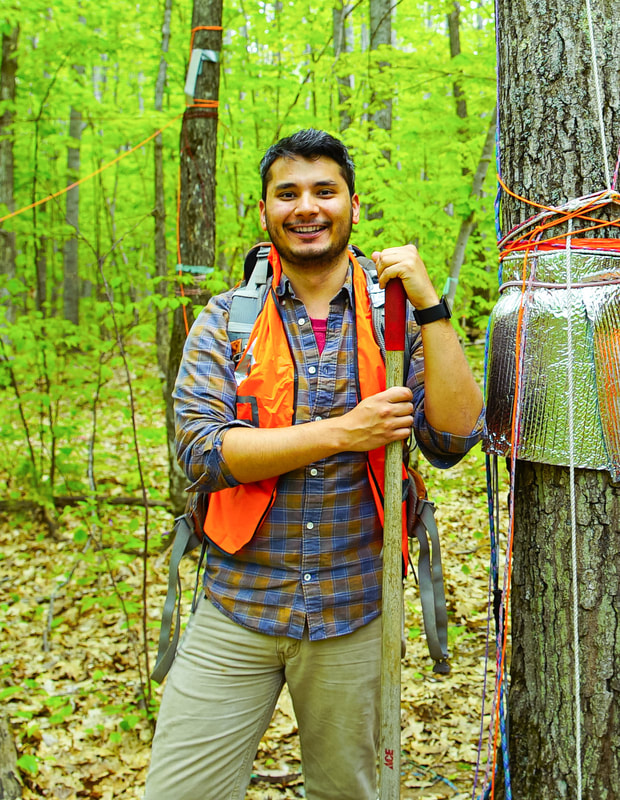Broadly, I think ecohydrology addresses the bi-directional interaction between hydrological and ecological processes. For me, actively participating in ecohydrological research has provided another way of thinking about and interacting with the world around me. Through asking ecohydrological questions, I have been able to practice skills related to science communication, quantitative reasoning, tool development, fieldwork, lab analyses, and proper mosquito and tick prevention. I have also been able to experience beautiful landscapes, bask in vibrant sunrises and sunsets (often during 24-hour field campaigns), discover new (to me) concepts, and form relationships with inspiring people. In reflecting on how I got to this point, I am thankful and proud to identify as an ecohydrologist.
What are your undergraduate and graduate degrees in?
B.A. in Geophysics and a minor in Math from SUNY Geneseo
M.S. in Geological Sciences from the University at Buffalo
Ph.D. in Geological Engineering from the University of Wisconsin-Madison
How did you arrive at working in/thinking about ecohydrology?
My path to get to ecohydrology was non-linear and seemed to happen after winnowing down broad interests and through the encouragement of many mentors to keep pursuing my interests. I do remember having interests in water and environmental issues from a young age, but I certainly did not know I could build a career around researching ecohydrology questions, let alone what “ecohydrology” was. I also didn’t know a lot about grad school or what a PhD was until I got to college. Anyways, I’ll start at the beginning of when I went off to college.
I started my undergraduate studies as a physics major. I also wanted to double major in art, but the art department got cut out the budget in my sophomore year (sad!). Another shift in my undergrad career happened when I took a class called Our Geologic Environment in my junior year. In that semester, I learned that I was much more interested in applying physics and math to learn about geological processes. I got involved in a research project with Dr. Scott Giorgis investigating the paleomagnetism of the Henry Mountains in Utah, which solidified my desire to pursue learning more about the geophysical sciences. I wrapped up my undergrad studies with a geophysics degree, but I didn’t know what aspect of geology/geophysics I liked most. I decided to enroll in the University at Buffalo’s M.A. in Geological Sciences program, to take graduate level classes and sift through and learn more about my academic interests.
After a year of learning more about geology, I transitioned into the M.S. program at UB and began working with Dr. Chris Lowry on a research project investigating the impact of aquifer geometry on groundwater-surface water interactions in mountain meadows. This seemed like the perfect opportunity for me to explore my interests in geophysics and hydrogeology. Our research site was in Yosemite National Park, and after a fun day pushing a GPR cart around the meadow, we sat on pothole dome to relax. I remember sitting down on the granitic rock, looking across the meadow and the vastness around me, and thinking to myself something along the lines of “How can I keep finding myself in places like this in research and in life?” I was easily moved by conducting fieldwork at such a beautiful place and working with a wonderful, encouraging mentor.
Following this experience, I was interested in learning more about the ways hydrology and geophysics could be synthesized to address the sustainability of natural and built ecosystems in the contexts of climate change and land use change. This led me to UW-Madison where I was advised by Dr. Steve Loheide through the Ph.D. program in Geological Engineering. Again, an incredible mentor helped me focus my research interests and it was somewhere in the middle of northern Wisconsin, socks pulled over my pants, shooting leaves off a tree in the middle of the night with a slingshot that I felt like I found my place as an ecohydrologist.
What do you see as an important emerging area of ecohydrology?
I’m excited for the directions that new technology, monitoring efforts, and continuous data streams will take the field in advancing ecohydrological observations and models across scales. Importantly, as more and more data in ecohydrology and other fields become freely available and accessible, I view this as an important opportunity for ecohydrologists to leverage in collaborating with diverse disciplines to address wicked problems holistically. The inclusion of diverse voices in ecohydrology will always be an important area to embrace in moving forward.
Do you have a favorite ecohydrology paper? Describe/explain.
When I was trying to figure out research directions for my dissertation, I drew a lot of inspiration from Vose et al., 2011’s paper, “Forest ecohydrological research in the 21st century: What are the critical needs?.” In particular, this paper ends with five calls for important future research directions; I was drawn in by four of them as it related to my interests and skills I wanted to develop: (1) Understanding watershed responses to climate change and variability; (2) Developing integrated models that capitalize on long-term data; (3) Linking ecohydrological processes across scales; and, (4) Managing forested watershed to adapt to climate change. These research needs are, still, worth pursuing and this paper helped me wrap my head around focusing my dissertation research, so I have appreciated its lasting impact on me.
What do you do for fun (apart from ecohydrology)?
I love to paint (digital, acrylic, oil), hike around, and cook new recipes. I just moved to Williamsburg, VA, so have been enjoying exploring this new area too!

 RSS Feed
RSS Feed